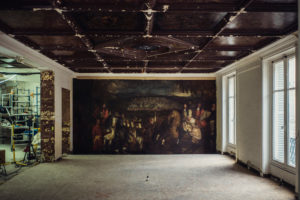Last week, the NY Times featured an article about a 17th-century painting discovered behind a wall in a Parisian commercial space. The 10-by-20-foot canvas was discovered during the renovation of an Oscar de la Renta boutique. The mysterious painting is of a 17th-century nobleman and his entourage entering the city of Jerusalem. Through the use of art experts and historians, it was revealed that the work was painted in 1674 by Arnould de Vuez, a painter who worked with Charles Le Brun, the first painter to Louis XIV and designer of interiors of the Château de Versailles. Le Brun, with a reputation for involvement in duels, eventually fled France and made his way to Constantinople.
It is unclear how the canvas found its way to Paris and was hidden behind the wall of the boutique (it’s speculated that it may have been hidden during WWII). But most interestingly, art historian Stephane Pinta expertly traced the painting to a plate that was reproduced in “Odyssey of an Ambassador: The Travels of the Marquis de Nointel, 1670-1680,” by Albert Vandal. The book, written in 1900, recounted the travels of Louis XIV’s ambassador to the Ottoman Court. The discovery of the book, which includes a rotogravure of the rediscovered painting, reveals that the painting is of Marquis de Nointel arriving in Jerusalem.
After discovering the identity of the painting and its creator, the restoration process began. A team of specialists worked to restore the painting to its original state. However, investigators are still working to study the painting, understand its iconography, and trace its provenance and movements from inception through today.
The story demonstrates the importance of thorough provenance investigations. However, this is not the first case involving the discovery of art hidden behind a wall; there are a number of well-known instances involving artistic masterpieces hidden behind walls. Perhaps the most famous hidden work involves Leonardo’s famed “The Battle of Anghiari.” But the work isn’t hidden in the usual way. Some believe it was in place sight, on (not behind) a wall in the Palazzo Vecchio in Florence. It’s believed that Leonardo’s now lost masterpiece (sometimes referred to as “the Lost Leonardo”) lies beneath a work by Giorgio Vasari. But with the work covered by another intact masterpiece, questions arise as to how to preserve these two dueling artworks.
Works are sometimes hidden due to criminal motivations. Fourteen years after two Van Gogh works were stolen from the artist’s eponymous museum in Amsterdam, officers in Italy’s Guardia di Finanza found the missing works in southern Italy. The paintings were hidden behind a wall in the home of a mafia boss.
Sometimes works are hidden due to family disputes and conflicting claims of ownership. In 2006, Sotheby’s sold a Norman Rockwell painting that had been hidden behind a wall by the painting’s owner. During their divorce, the owner of the work did not want his wife gaining possession of, or making copies of, “Breaking Home Ties.” He hid the painting behind the wall, but his sons discovered the artwork after their father’s passing.
There are a host of other stories involving the discovery of works hidden behind walls, even by the artists themselves. It is always exciting when a work is rediscovered.
